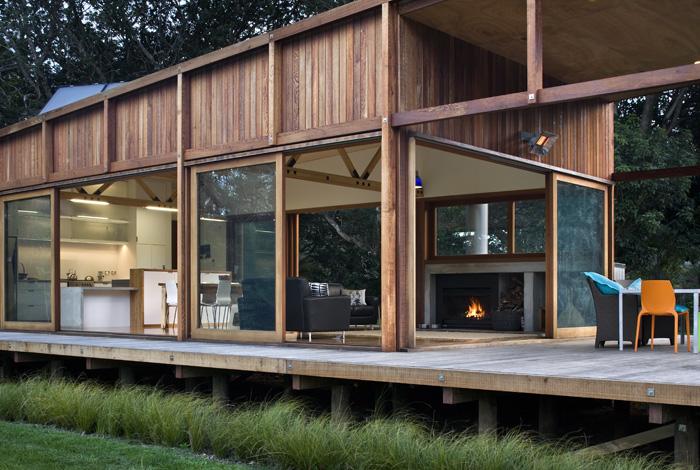An Austrian couple builds a 1,000-square-foot box made of certified wood.
ByLloyd Alter Lloyd AlterDesign EditorLloyd Alter is Design Editor for Treehugger and teaches Sustainable Design at Ryerson University in Toronto.Learn about our editorial processPublished March 9, 2022 01:00PM ESTFact checked byKatherine Martinko Fact checked byKatherine MartinkoKatherine Martinko is an expert in sustainable living. She holds a degree in English Literature and History from the University of Toronto.
Learn about our fact checking processNewsSwiss architect and city planner Le Corbusier built the Villa Savoye on the outskirts of Paris on stilts "to provide an actual separation between the corrupted and poisoned earth of the city and the pure fresh air and sunlight of the atmosphere above it." And he didn't know about radon gas. When I imagined my dream house, I dreamed it would be built on stilts to minimize the use of the concrete and foam insulation you usually find in foundations.
Andrea Hörndler and Hannes Wizany built their house, Place to Be, in Linz, Austria, on stilts. It is on a steep hillside lot—a basement would have cost a fortune and used a lot of material. Instead, they built a lightweight structure out of recycled steel and plopped a wood box on top. Why steel?
"The loads that the wood would have to carry would result in very oversized supports, which simply would not have been a solution for us. Steel has enormous structural advantages in construction. In addition, structural steel is mainly made from recycled steel, so old cars, washing machines, etc. are recycled and processed. So who knows what our supports have already experienced."The modest 1,000-square-foot box on top is made of certified wood—either FSC (Forest Stewardship Council) or a European certification, PEFC (Programme for the Endorsement of Forest Certification), which is apparently not quite as strict. Hörndler writes, "PEFC acts particularly in the interest of forest owners and relies on simplified and cheaper procedures. This certification process makes it cheaper and easier for owners and large areas of forest can be certified."
The house is insulated with a product I have never seen before: blow-in straw. It is apparently easier to install than the straw bale we have shown previously. Hörndler explains: "ISO straw came onto the market in 2017. Similar to cellulose or wood fiber, the certified straw can be blown into the wall structures of almost any construction. Due to the high insertion density, the insulation is resistant to settlement and serves as protection against the cold in winter and keeps the interior pleasantly cool in summer." The walls are 16 inches thick so it will be cozy indeed.

I have considered using straw bale insulation but was a bit nervous about feeding the local mice, but Hörndler says this is not a problem. "Straw does not contain any nutrients and is therefore not one of the tastiest meals," she noted. "In addition, ISO straw is blown into the walls so compactly that there is no room at all for mice or the like. So if the mouse or the hamster ever disappears from the cage - you don't have to look for them in the walls."
This looks like a really interesting product, but has a terrible name; ISO also stands for International Standards Organization, and a Google search keeps coming up with ISO approved drinking straws. However, another search indicates that the company is considering a name change to Istraw.
The plan is simple and efficient: two bedrooms and one bath, with the toilet in its own room. In North America, there would be a second toilet in an apartment smaller than this. Note also the huge amount of storage—by the entry, by the principal bedroom, and even a sort of bike storage room.
Another interesting feature is the extensive use of Agrob Buchtal Hytect ceramic tile made with titanium dioxide. According to a press release:
"The effect of Hytect is based on the principle of photocatalysis. For this purpose, titanium dioxide is durably baked into the glaze of the ceramic tiles as a 'catalyst' which, when exposed to light, effects a reaction between light, oxygen, and air humidity. In this way, active oxygen is formed which, on the one hand, eliminates unpleasant odours and air pollutants including formaldehyde, tobacco, kitchen fumes, and typical WC odours. On the other hand, the active oxygen decomposes and inhibits the growth of micro-organisms such as bacteria, mould, algae, moss, and germs without chemical substances."The interior walls are clay, installed by Hörndler herself, in a process she describes as "definitely doable, it does get on your nerves from time to time - but once the walls are all finished, it's really a good feeling what you can do if you want to."
There is a lot to love in this project, from the way it sits lightly on the ground, to the simple and modest plan, to the careful choice of healthy materials. And also, the documentation. They didn't just build a house, but see it as "a showcase project and a platform for those interested in building and living. In the initial research phase, we noticed that there are only a few informative sources that cover an entire project." Nice work by Hörndler, Wizany, and architect Christoph Wiesmayr, who did an interesting interview that sounds like Treehugger:
"Building ecologically has nothing to do with 'hippie architecture' anymore. Living in cramped and stuffy caravans, insect-infested walls, elaborate straw bale constructions are history for me. We are now many technological steps ahead. There are new, lighter and more sensible uses for clay, wood and straw. I am also an advocate of 'LOW-TECH'. The 'smart home' concept is currently being proclaimed to be forward-looking. However, I believe that we, as responsible people, do not have to make ourselves too dependent on technical aids."See it all at Place to Be, in German but the Google translation is excellent. Also, Hörndler points us to their Instagram account.
